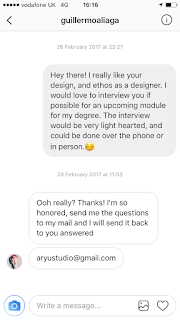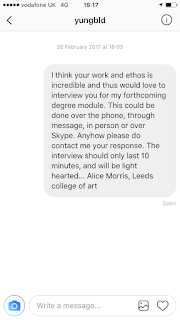What is the main struggle you have had yourself since coming out of university?
Do you ever feel that you are sometimes belittled for being a creative rather than taking a more 'academic' root such as science?
Do you find it hard to balance projects in which you would like to take on with a smaller income, compared to that of larger projects in which you need to sustain the business?
Where do you see yourself as a creative heading in the next ten years alongside the company?
So how come you decided to stay up North, rather than say London, the hub of graphic design?
Throughout your career what project has stood out to you the most, and that you have enjoyed doing?
Do you think printed media is still relevant?
What's your favourite colour?
If you were to label yourself what would your job title be other than creative director?
Who are you favourite designers?
What's your golden rule for design?
If you could change anything about the design industry what would it be?
Who is your biggest motivator?
Will you be a creative forever?
What's your advice to a young creative?
As I was unsure upon what questions to ask Tim, John stated that I should select questions in which would help myself/guide my career path. As a result of this the below questions were selected with the reasonings being outlined.
What is the main struggle you have had yourself since coming out of university? As I will be soon leaving university it is essential that I am aware of the struggles faced by other professionals in order to prepare oneself.
Do you ever feel that you are sometimes belittled for being a creative rather than taking a more 'academic' root such as science? I often feel that taking an art related degree is seen as 'easy' and thus I want to ask the following question in order to gain a greater insight into whether this is relevant in industry.
Do you find it hard to balance projects in which you would like to take on with a smaller income, compared to that of larger projects in which you need to sustain the business? As I belive ethics are a strong aspect of design I would like to gain a greater insight into Tim's ethics.
Where do you see yourself as a creative heading in the next ten years alongside the company? As I may be interested in joining their company, I believe it is important to ask essential questions in order to gain a greater understanding upon the company's future.
So how come you decided to stay up North, rather than say London, the hub of graphic design?
Do you ever feel that you are sometimes belittled for being a creative rather than taking a more 'academic' root such as science? I often feel that taking an art related degree is seen as 'easy' and thus I want to ask the following question in order to gain a greater insight into whether this is relevant in industry.
Do you find it hard to balance projects in which you would like to take on with a smaller income, compared to that of larger projects in which you need to sustain the business? As I belive ethics are a strong aspect of design I would like to gain a greater insight into Tim's ethics.
Where do you see yourself as a creative heading in the next ten years alongside the company? As I may be interested in joining their company, I believe it is important to ask essential questions in order to gain a greater understanding upon the company's future.
So how come you decided to stay up North, rather than say London, the hub of graphic design?
As I am unsure upon whether I want to stay up north or not I believe this question to be highly relevant.
Throughout your career what project has stood out to you the most, and that you have enjoyed doing? Taking a personal insight into Tim's account will make the interview personal, and thought provoking.
Throughout your career what project has stood out to you the most, and that you have enjoyed doing? Taking a personal insight into Tim's account will make the interview personal, and thought provoking.













































